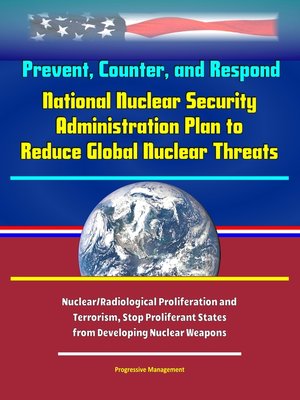Prevent, Counter, and Respond
ebook ∣ National Nuclear Security Administration Plan to Reduce Global Nuclear Threats, Nuclear/Radiological Proliferation and Terrorism, Stop Proliferant States from Developing Nuclear Weapons
By Progressive Management

Sign up to save your library
With an OverDrive account, you can save your favorite libraries for at-a-glance information about availability. Find out more about OverDrive accounts.
Find this title in Libby, the library reading app by OverDrive.



Search for a digital library with this title
Title found at these libraries:
| Library Name | Distance |
|---|---|
| Loading... |
The Department of Energy (DOE) performs a unique and indispensable role in reducing global nuclear and radiological dangers, contributing to U.S. national security and global security writ large. Chiefly performed through the work of DOE's National Nuclear Security Administration (NNSA), these activities comprise the Prevent-Counter-Respond framework, which provides a dynamic defense-in-depth against current and long-term nuclear threats.
Under this framework, NNSA works to prevent would-be proliferant states and non-state actors from acquiring nuclear weapons or weapons-usable nuclear material (WUNM), counter efforts of both would-be proliferant states and non-state actors to acquire or develop these capabilities, and respond to nuclear incidents worldwide, whether deliberate terrorist acts or nuclear accidents. As part of an all-hazards emergency management program, and in close cooperation with our interagency and international partners, we continuously monitor the global landscape to ensure the United States can anticipate and respond to developments that may threaten the nation's security. DOE/NNSA's threat reduction programs address a number of challenges, including inadequately secured nuclear and radioactive materials in regions of concern and increasing global stockpiles of WUNM. Growing interest in civil nuclear power, particularly in the developing world, could increase the number of latent nuclear-threshold states, underscoring the importance of DOE/NNSA's contribution to strengthening the international nuclear safeguards regime. These countries may also have little or no experience in safely managing nuclear facilities and protecting nuclear materials, presenting a vulnerability that malicious actors may seek to exploit.
Chapter 1 Introduction * Meeting the Challenges of Nuclear/Radiological Proliferation & Terrorism * 1.1 Overview: Nuclear/Radiological Threat Reduction is a Core DOE/NNSA Mission * 1.1.1 DOE/NNSA Offices Primarily Responsible for Nuclear and Radiological Threat Reduction * 1.2 Characterizing the Current Nuclear Threat Environment * 1.2.1 Global and Regional Nuclear/Radiological Proliferation * Nuclear/Radiological Terrorism * Emerging, Converging, and Disruptive Technologies * 1.2.4 Preparing for the Unanticipated * 1.3 NNSA Core Capabilities * 1.3.1 NNSA Expertise * 1.3.2 NNSA Innovation * NNSA Partnerships and Collaborations * Chapter 2 NNSA's Plan to Prevent, Counter, and Respond to the Challenges of Nuclear/Radiological Proliferation & Terrorism * 2.1 Prevent: Preventing Nuclear/Radiological Proliferation and Terrorism * 2.2 Counter: Countering Nuclear/Radiological Proliferation and Terrorism * 2.3 Respond: Responding to Nuclear/Radiological Threats and Terrorism * 2.4 Ensuring World Class Infrastructure and Workforce * 2.4.1 Infrastructure Base and the Nuclear Risk Reduction Mission Infrastructure Challenges * 2.4.3 Workforce Base and the Nuclear/Radiological Risk Reduction Mission Workforce Challenges and Opportunities * Chapter 3 Conclusion
This compilation includes a reproduction of the 2019 Worldwide Threat Assessment of the U.S. Intelligence Community.






